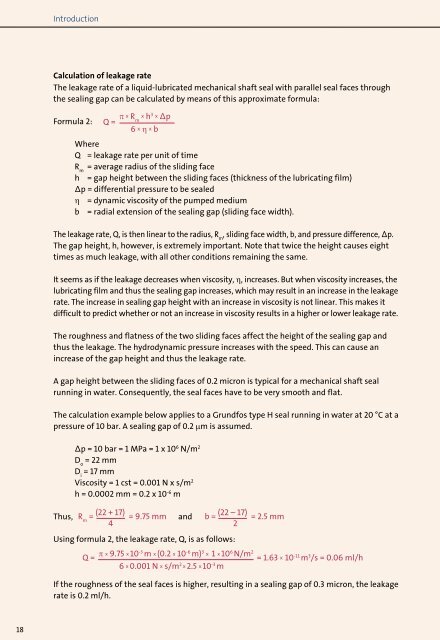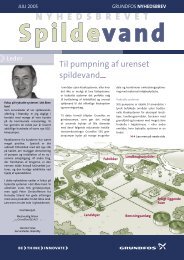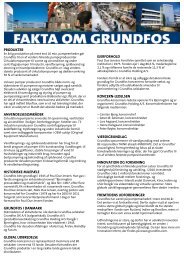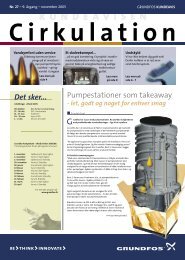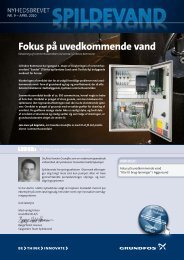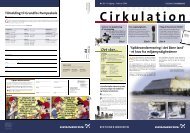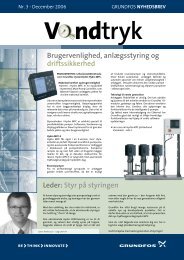Mechanical shaft seals for pumps - Grundfos
Mechanical shaft seals for pumps - Grundfos
Mechanical shaft seals for pumps - Grundfos
Create successful ePaper yourself
Turn your PDF publications into a flip-book with our unique Google optimized e-Paper software.
18<br />
Introduction<br />
Calculation of leakage rate<br />
The leakage rate of a liquid-lubricated mechanical <strong>shaft</strong> seal with parallel seal faces through<br />
the sealing gap can be calculated by means of this approximate <strong>for</strong>mula:<br />
Formula 2: Q = π x R m x h 3 x ∆p<br />
6 x η x b<br />
R = m<br />
4<br />
(22 + 17) = 9.75 mm<br />
b =<br />
2<br />
(22 – 17) Where<br />
Q = leakage rate per unit of time<br />
R = average radius of the sliding face<br />
m<br />
h = gap height between the sliding faces (thickness of the lubricating film)<br />
Δp = differential pressure to be sealed<br />
h = dynamic viscosity of the pumped medium<br />
b = radial extension of the sealing gap (sliding face width).<br />
= 2.5 mm<br />
The leakage rate, Q, is then linear to the radius, R , sliding face width, b, and pressure difference, Δp.<br />
m<br />
The gap height, h, however, is extremely important. Note that twice the height causes eight<br />
times as much leakage, with all other conditions remaining the same.<br />
b =<br />
2<br />
(22 – 17) It seems as if the leakage decreases = 2.5 mmwhen<br />
viscosity, h, increases. But when viscosity increases, the<br />
lubricating film and thus the sealing gap increases, which may result in an increase in the leakage<br />
rate. The increase in sealing gap height with an increase in viscosity is not linear. This makes it<br />
difficult to predict whether or not an increase in viscosity results in a higher or lower leakage rate.<br />
Q = π x 9.75 x 10-3 m x (0.2 x 10-6 m) 3 x 1 x 106 N/m2 = 1.63 x 10-11 m3 /s = 0.06 ml/h<br />
6 x 0.001 N x s/m2 x 2.5 x 10-3 The roughness and flatness of the two sliding faces maffect<br />
the height of the sealing gap and<br />
thus the Q leakage. = The hydrodynamic pressure increases with the speed. This can cause an<br />
increase of the gap height and thus the leakage rate.<br />
π x R x h m 3 x ∆p<br />
6 x η x b<br />
A gap height between the sliding faces of 0.2 micron is typical <strong>for</strong> a mechanical <strong>shaft</strong> seal<br />
running in water. Consequently, the seal faces have to be very smooth and flat.<br />
The calculation example below applies to a <strong>Grundfos</strong> type H seal running in water at 20 °C at a<br />
Q =<br />
pressure of 10 bar. A sealing gap of 0.2 mm is assumed.<br />
π x R x h m 3 x ∆p<br />
6 x η x R = m<br />
4<br />
b<br />
(22 + 17) = 9.75 mm<br />
Δp = 10 bar = 1 MPa = 1 x 106 N/m2 D = 22 mm<br />
o<br />
D = 17 mm<br />
i<br />
Viscosity = 1 cst = 0.001 N x s/m2 h = 0.0002 mm = 0.2 x 10-6 Q =<br />
m<br />
Thus,<br />
π x R x h m 3 x ∆p<br />
6 x η x b<br />
R = m<br />
4<br />
(22 + 17) b =<br />
2<br />
= 9.75 mm and<br />
(22 – 17) = 2.5 mm<br />
b =<br />
2<br />
(22 – 17) = 2.5 mm<br />
Using <strong>for</strong>mula 2, the leakage rate, Q, is as follows:<br />
b =<br />
2<br />
(22 – 17) = 2.5 mm<br />
b =<br />
2<br />
(22 – 17) Q =<br />
= 2.5 mm<br />
π x 9.75 x 10-3 m x (0.2 x 10-6 m) 3 x 1 x 106 N/m2 = 1.63 x 10-11 m3 /s = 0.06 ml/h<br />
6 x 0.001 N x s/m2 x 2.5 x 10-3 m<br />
If the roughness of the seal faces is higher, resulting in a sealing gap of 0.3 micron, the leakage<br />
rate is 0.2 ml/h.<br />
b =<br />
2<br />
(22 – 17) = 2.5 mm<br />
R = m<br />
4<br />
(22 + 17) = 9.75 mm<br />
b =<br />
2<br />
(22 – 17) = 2.5 mm<br />
Q = π x 9.75 x 10-3 m x (0.2 x 10-6 m) 3 x 1 x 106 N/m2 = 1.63 x 10-11 m3 /s<br />
6 x 0.001 N x s/m2 x 2.5 x 10-3 m


